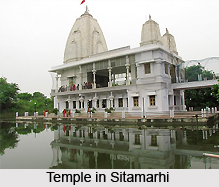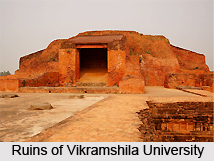 Tirhut is a region located in Bihar. The name Tirhut is taken from the Sanskrit word "Tirbhukti" which means a land bounded by three rivers. The rivers bounded the Tirhut are Gandak River in the west, Kosi River in the east and Ganga River in the south. There are several rivers flowing through this region from north to south and merge in river Ganges. Major rivers of Tirhut are Mahananda River, Gandak River, Kosi River, Bagmati River, Kamala River, Balan River, Budhi Gandak River.
Tirhut is a region located in Bihar. The name Tirhut is taken from the Sanskrit word "Tirbhukti" which means a land bounded by three rivers. The rivers bounded the Tirhut are Gandak River in the west, Kosi River in the east and Ganga River in the south. There are several rivers flowing through this region from north to south and merge in river Ganges. Major rivers of Tirhut are Mahananda River, Gandak River, Kosi River, Bagmati River, Kamala River, Balan River, Budhi Gandak River.
Muzaffarpur is a major settlement in the Tirhut region. In this region, Darbhanga, Barauni, Saharsa and Purnia are the other important towns within the region. Vaishali, Lichhavi, Sitamarhi District and Darbhanga are tourist destinations in Tirhut.
Early History of Tirhut
According to the Indian epic, Ramayana, King Sirdhwaj Janaka, the 21st king of the Janaka Dynasty, ruled Videha. Sitamarhi (now Sitamarhi District) a place in this region, bears a value of sacred Hindu belief where, Sita sprang to life out of an earthen pot while Rajarshi Janak was tilling the land. There had been 57 kings in this dynasty.
After the end of the Janaka dynasty, Tirhut was divided into 8 states and power was devolved to local elected representatives. Tirhut was the world`s first democratic republic. During this period, Tirhut was known as the Vajji Republic or the Great Union of Vajji.
Even the powerful kingdom of Magadha had to conclude matrimonial alliances in 519 B.C. with the neighbouring estates of the Licchavis Tribe. Ajatshatru invaded Vaishali and extended his sway over Tirhut. It was at this time that Patliputra (the modern Patna) was founded at the village Patali on the banks of the sacred Ganga River and Ajatshatru built an invincible fortress to keep vigil over the Licchavis on the other side of the river.

Medieval History of Tirhut
From the visit of Hieuen Tsang until the rise of the Pala dynasty in Indian medieval history, Tirhut was under the control of King Harshavardhana. After 647 A.D., the region passed on to the local chiefs. In the 8th century A.D., the Pala kings continued to have their hold over Tirhut until 1019 A.D. Later Chedi kings of Central India ruled until they were replaced by the Sena dynasty in 11th century.
During the time of Delhi Sultanate, Ghais-u-ddin Iwaz, the ruler of Bengal, was the first Muslim invader of Tirhut. He, however, could not succeed in conquering the kingdom but extorted tributes. It was in 1323 that Ghiyasuddin Tughlaq established his control over Tirhut.
During the regime of Harasimha Deva, the last king of the dynasty, Tughlaq Shah invaded Tirhut in 1323 and gained control over the territory. Tughlaq Shah handed over the management of Tirhut to Pandit Kameshwar Thakur. Thus, the sovereign power of Tirhut passed from the Hindu chiefs to the Muslims but the Hindu chief continued to enjoy complete autonomy. During this period, Vidyapati Thakur was a Maithili poet and Sanskrit scholar in the region. He was born in Village Bisphi of Madhubani. This place is famous for Madhubani paintings and art.
Modern History of Tirhut
With the emergence of British East India Company in 1764 and after the battle of Buxar the British East India Company controlled over whole of Bihar and Trihut. The success of the insurgent at Delhi in 1857 caused concern to the English inhabitants in Tirhut and revolutionary fervour began to permeate the entire region.
Economy of Tirhut
Agriculture is the main economic activity of this region is relatively poor region. The main crops are rice, wheat, pulses, moong dal, urad, arhar, jute and maize. Further cash crops include chillies, coriander, turmeric, ginger, bananas and tobacco.



















